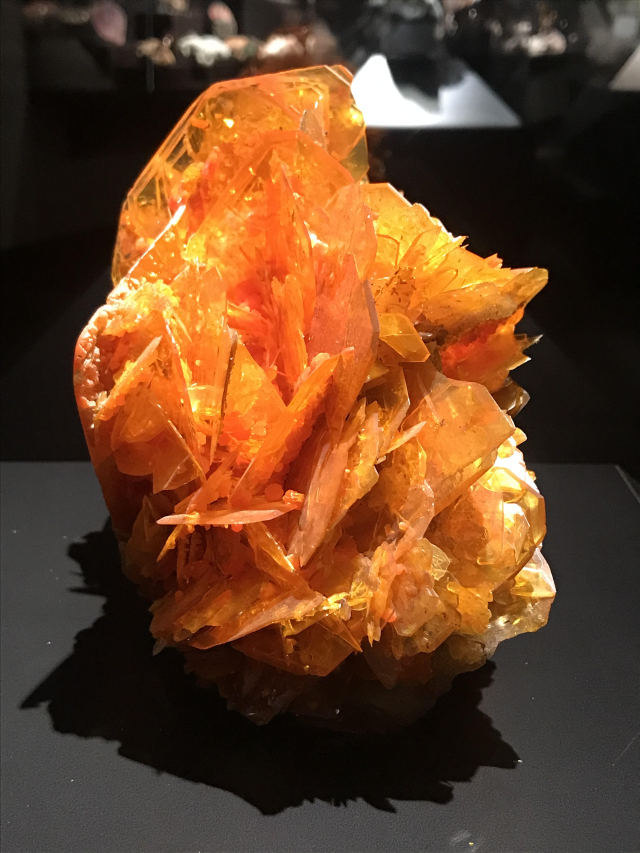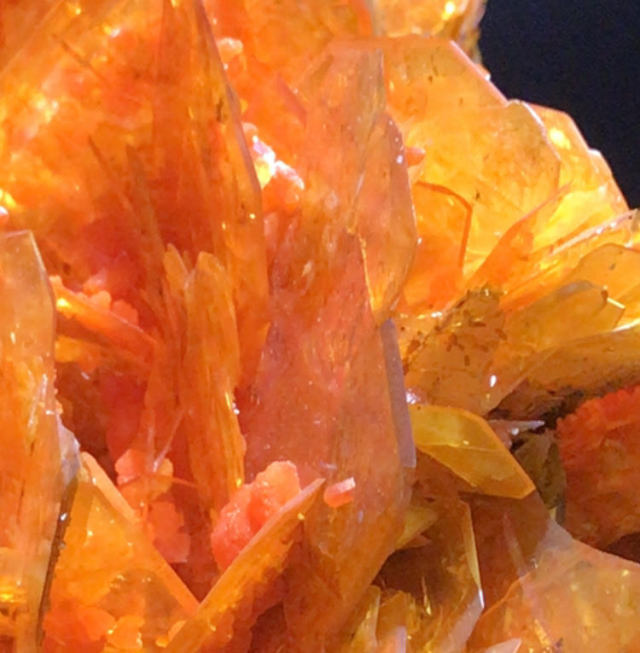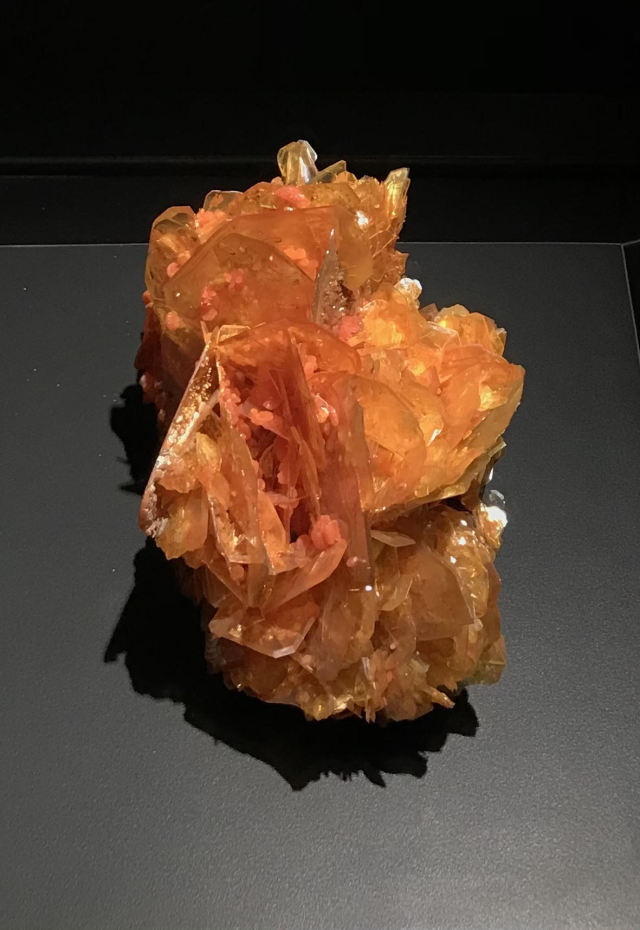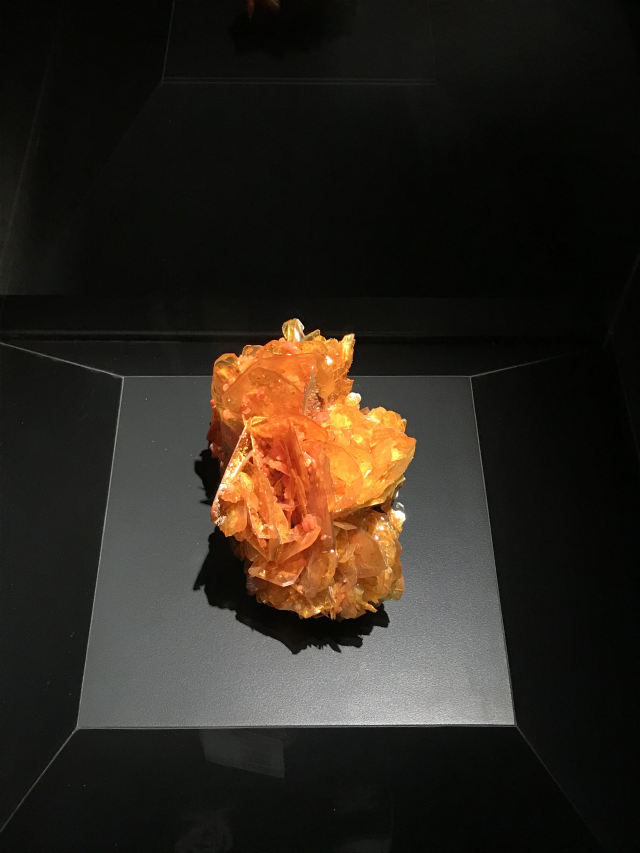by Nicholas Sauer
Scientific information provided by Dr. Carla Rosenfeld, Assistant Curator of Earth Sciences
Carnegie Museum of Natural History’s specimen of Wulfenite and Mimetite is one of its most fascinating. It first caught my attention because it looks so distinctly like a piece of abstract art made out of honey barbeque potato chips. It was only afterward that I discovered that the museum’s official nickname for the specimen is appropriately just that, “BBQ Chips.”

The potato-chip-shaped structures in question are thin, tabular crystals of wulfenite. A crystal is the physical, three-dimensional form that a mineral takes on in nature. The wulfenite is thin, broad, and relatively flat just like a table is, so that’s why scientists classify it as “tabular.” Sometimes, due to the conditions under which it was formed, wulfenite might also take on the shape of small pyramids.

The naming of wulfenite has a fascinating history itself. It was first discovered and described in the late 18th century by Austrian mineralogist Ignaz von Born (1741-1791) who gave it the name plumbum spatosum flavo pellucidum. Now, don’t be intimidated by the Latin, it is just a literal description of what von Born thought he found: yellow glasslike lead ore. Scientists later renamed the mineral wulfenite in 1845 when they discovered a deposit of it in Bleiberg, Austria. The new namesake, Franz Xavier von Wulfen (1728-1805), had spent his professional life studying the lead ores of the area. The mineral was also sometimes called melinose, after the Greek word “meli” meaning “honey,” so it is not surprising that the specimen first brought to my mind the image of honey barbeque chips in color as well as shape. While it was Austrian scientists who gave it its modern-day name, wulfenite exists in many locations around the world, including China, Arizona, and Mexico. Wulfenite even became Arizona’s state mineral in 2017. Our own BBQ chips specimen came from the San Francisco mine in Sonora, Mexico and was acquired in 1988.
However, there’s more than just wulfenite on display behind the glass in CMNH’s Hillman Hall of Gems and Minerals. If you look closer you will see groups—aggregates—of small spheres interspersed among the crystalline potato chips. These small spheres are composed of the mineral mimetite, which often forms alongside wulfenite in nature as both are leaden in their chemical makeup. Specifically, mimetite is a mineral that forms as a product of the oxidation of galena (lead sulfide) and arsenopyrite (iron arsenic sulfide). Mimetite got its name because it “mimics” the appearance of other lead-based minerals, particularly pyromorphite. The aggregates of mimetite you see at the museum have what scientists call a “botryoidal habit.” Translation: the mineral has a characteristic shape—habit—which in this case is grape-like—“botryoidal,” from the Greek. So, again, it isn’t so outlandish to describe wulfenite as “potato-chipian” when mimetite is described by scientists literally as a “cluster of grapes.” In fact, I’m starting to get a little hungry. Scientists often name their new discoveries after something familiar to them that has a similar shape or property.
But how did “BBQ Chips” come to take on its unique shape and remarkable coloration? Specific patterns of atoms that make up the minerals’ internal structure give wulfenite and mimetite their repeating and intricate form. The color of the specimens depends on their chemical composition. For instance, the wulfenite on display at CMNH gets its fiery orange hue from trace amounts of chromium lurking deep within the crystal. It is ironic that what scientists call an “impurity”—the chromium—gives the wulfenite one of its most striking and aesthetically pleasing features, its coloration. The mimetite, on the other hand, has a similar burnished orange color because of the presence of arsenic, mimetite being composed of lead chloride arsenate.

The Carnegie Museum of Natural History’s specimen of wulfenite and mimetite showcases the beauty and complexity of the natural world, the entwining of two distinct and breathtaking minerals in one display. Their bright colors and arresting shapes are the product of chemical reactions, time, and specific environmental conditions. The gastronomical names that their coloration and visible structures have garnered over the years—from “BBQ Chips” to “clusters of grapes”—make them a mineralogical feast for scientists and museum patrons alike.

Nicholas Sauer is a Gallery Experience Presenter in CMNH’s Life Long Learning Department. Museum staff, volunteers, and interns are encouraged to blog about their unique experiences and knowledge gained from working at the museum.
References
Ascarza, William. “Wulfenite, Arizona’s State Mineral, is Theme for Current Tucson Gem Show.” Tucson.com. 12 April 2020. <https://tucson.com/news/local/wulfenite-arizonas-state-mineral-is-theme-for-current-tucson-gem-show/article_00d6cbc2-80bb-57fd-8288-9ba0f189041f.html>.
“Mimetite.” Smithsonian National Museum of Natural History. <https://geogallery.si.edu/10026354/mimetite>.
“Minerals, Crystals, and Gems: Stepping Stones to Inquiry.” Smithsonianeducation.org. 2013 <http://www.smithsonianeducation.org/educators/lesson_plans/minerals/minerals_crystals.html>.
“Mineral of the Year 2020.” Naturhistorisches Museum Wien. 2020. < https://www.nhm-wien.ac.at/en/research/mineralogy__petrography/mineral_of_the_year>.
Russell, Peter. “Oxidized Zone Minerals.” University of Waterloo. 1 March 2006. <https://waterloo.ca/wat-on-earth/news/oxidized-zone-minerals>.
“Wulfenite.” Smithsonian National Museum of Natural History. <https://geogallery.si.edu/10026003/wulfenite>.
“Wulfenite—Collected from Sonora, Mexico.” Saint Louis Science Center. 2021. <https://www.slsc.org/wulfenite-collected-from-sonora-mexico/>.
Related Content
Super Science Activity: DIY Sundial
Carnegie Museum of Natural History Blog Citation Information
Blog author: Sauer, NicholasPublication date: June 21, 2021
Share this post!
Share this post!
